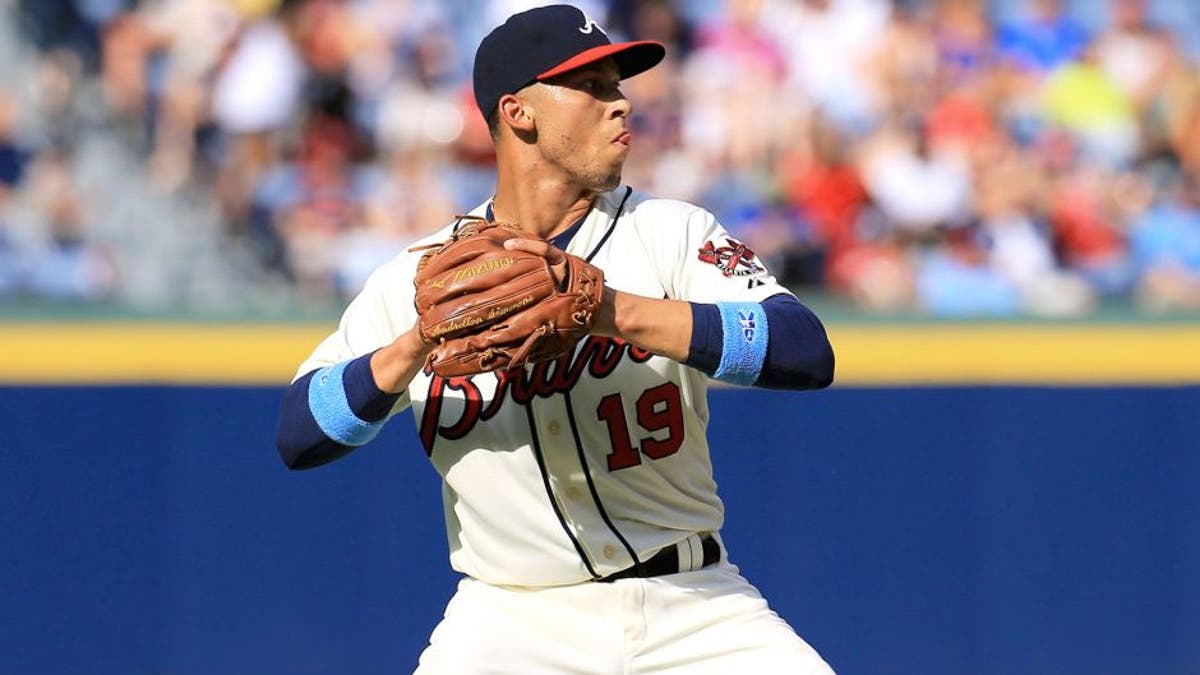
ATLANTA, GA - JUNE 21: Andrelton Simmons #19 of the Atlanta Braves fields a ball during the game against the New York Mets at Turner Field on June 21, 2015 in Atlanta, Georgia. (Photo by Daniel Shirey/Getty Images)
BOCA RATON, Fla. -- Now that the Atlanta Braves have traded shortstop Andrelton Simmons to the Los Angeles Angels, they will have some serious explaining to do.
The return includes shortstop Erick Aybar, top pitching prospects Sean Newcomb and Chris Ellis and cash, and the Braves no doubt will trumpet that they're stockpiling more young pitching talent.
But Simmons isn't like Jason Heyward and Justin Upton, who were entering their free-agent years. He isn't like Evan Gattis, who was more of an American League player. And he isn't like Craig Kimbrel, whom the Braves were willing to trade in large part because it freed them of Melvin Upton Jr.'s remaining guarantee.
No, Simmons was one of the Braves' core players, one of their most identifiable talents. He will play next season at 26. He is signed for the next five seasons for a club-friendly $53 million. And on Wednesday night, he was named the Wilson Defensive Player of the Year. Not just for his team. For all of baseball.
At some point, the Braves need to stop.
Lest we forget, they are opening a new ballpark, SunTrust Park, in 2017. Teams generally like to build momentum as they move into new parks, following the example of the mid-1990s Indians -- a team run by, ahem, none other than the Braves' current president of baseball operations, John Hart.
Remember?
Hart, assisted by future Rockies GM Dan O'Dowd, began the now-common practice of signing young core players to long-term deals. The Indians locked up 12 such players, including Carlos Baerga, Kenny Lofton, Jim Thome and Manny Ramirez. And it worked. Boy, did it work.
In 1994, the inaugural season at Jacobs Field, the Indians ended a streak of seven consecutive losing seasons. In '95, they went 100-44 in a strike-shortened campaign, beginning a run in which they reached the playoffs six times in seven years and the World Series twice.
That was the year that the Indians began a streak of 455 straight sellouts, a streak that did not end until April 4, 2001. And that period was when Hart made his reputation, producing the most golden era in Indians history.
Maybe Hart, with John Coppolella as his GM, will pull off the same feat in Atlanta; the Astros certainly benefited from a complete teardown, and the trade of Simmons continues the pattern. The Braves also hold the No. 3 pick in next year's draft and the same slot in the international bonus pool allocation, and the way they are headed, they figure to pick in the top 10 the year after that as well.
Hart had more time to build the Indians -- he was an integral part of their front office before becoming their GM in Sept. 1991. The Braves, for a variety of reasons, perhaps need to be more nimble with their retooling. But what is the end game here? First baseman Freddie Freeman would be next, right? When exactly would the Braves be good again? Why would fans even want to watch this team play?
Coppolella seemingly has latitude under Hart, and certainly seems to love the action -- he's almost like an east-coast version of the Padres' A.J. Preller. Maybe the grand plan will work, and the Braves will turn around quickly, and if it's a year or two after the ballpark opens, so be it. But this strategy also comes with risk.
Simmons, mostly due to the strength of his defense, is one of the top five shortstops in the game according to the two primary versions of Wins Above Replacement (WAR). He is the kind of player you build around, not the kind you move.
Now that the Braves have traded him, they might spend years trying to replace him. Now that they've traded him, the final season at Turner Field will be that much more painful. The first season at SunTrust Park, too.
